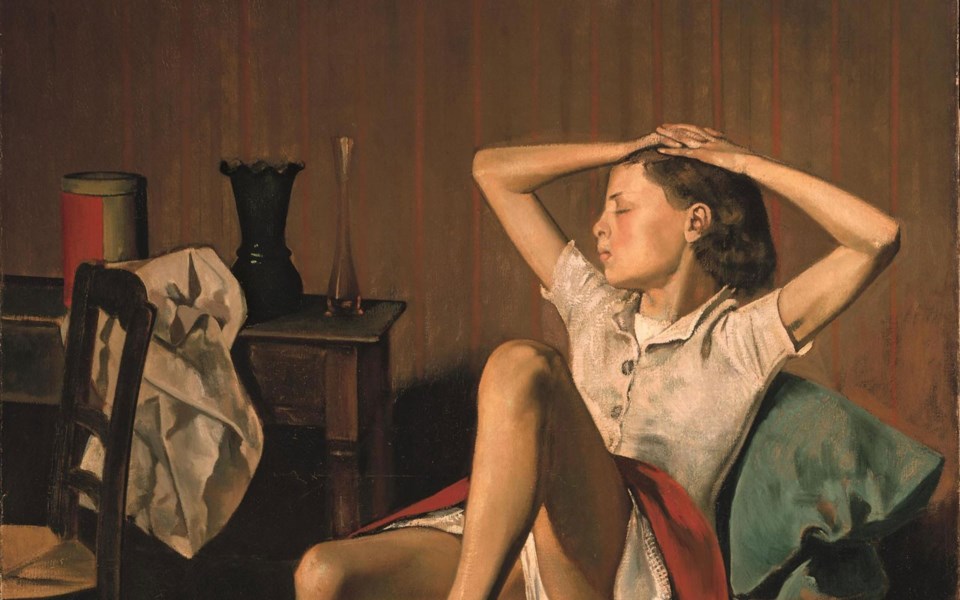A controversial painting at the Metropolitan Museum of Art has caused quite the stir in recent weeks, with more than 11,000 petitioning to have it removed from public view.
The 1938 work, Thérèse Dreaming, by French-Polish painter Balthus, is undeniably suggestive, depicting a young girl lost in reverie while reclining in a wooden chair, her underwear exposed. A cat lapping up a bowl of milk besides her adds another potential layer of innuendo.
The petition places the image squarely in today's "current climate around sexual assault and allegations that become more public each day," arguing it romanticizes "voyeurism and the objectification of children." The petition's author, HR professional Mia Merrill, asks the museum to either replace the painting with a work by a female artist of the same period or add context to its description.
Thus far, The Met has refused to remove the painting, calling it "an opportunity for conversation." And they were absolutely right not to.
While Balthus has spurred the ire of protesters in the past for for his voyeuristic predilections, his works are no more provocative than many of his artistic contemporaries and predecessors who we have since granted canonical status. For centuries, the more explicit sections of Michelangelo's magnum opus, the Sistine Chapel, were covered up, and on more than one occasion, censors tried to completely paint over one of the most monumental works in art history. Bernini's meticulously sculpted marble often depicted rape and female masturbation. Manet scandalized Parisians in the mid-1860s with his painting, Olympia, showing a reclining nude woman draped across a bed of flowers. Picasso, perhaps the most celebrated artist of the 20th century, was another magnet for detractors who criticized his abstraction of the female form.
These works are all done by men, who were virtually the only ones allowed to practice art for much of Western history, and who have clearly benefited from their inherent privilege in society. But the reality is we will always find something shameful and inappropriate in works of bygone eras if we choose to judge them solely by modern standards. If a work doesn't jive with the accepted social norms of the day, then we need to place it within its proper historical context, not whitewash it from memory.
It's also important to remember in our current cultural moment that art, by its very nature, invites multiple interpretations, Balthus included. Thérèse Dreaming is interesting simply because it means more than one thing, and asks the viewer to bring their own perspective to it.
"Unlike pornography, which we know it when we see it, Balthus throws us into a nether region of being unsure of what we're seeing at all," writes art critic Jerry Saltz. "Even if it's only coy, that's still not all that it is."
The waters get murkier when the content of a creator's work is so closely entangled with their troubling behaviour, as in the more recent examples of Louis CK's comedy and Woody Allen's films. But even in those instances, there is something to be taken from their work if only to analyze how these powerful men chose to benefit from that dynamic and exorcize their personal demons through their art. It's a chance for reckoning, not just for the accused, but society as a whole. How did we get to this place? We can still abhor their actions without erasing their work, and nobody's arguing they should be venerated in the pop culture hall of fame of our memories. Consumers, after all, will judge whether to continue supporting their careers with their wallets.
Great art is meant to prod and provoke, to challenge our accepted ways of thinking, to offend and spur debate. If it didn't, we'd still be left staring at oil paintings of mountain landscapes and bowls of shiny fruit. But in our rush for the moral high ground, there has been a tendency to shut down difficult conversations before they've even had a chance to start. And at a time when dialogue on sexual assault and the system that has allowed it to persist for generations is needed more than ever, we should be fostering conversation, not discouraging it.




